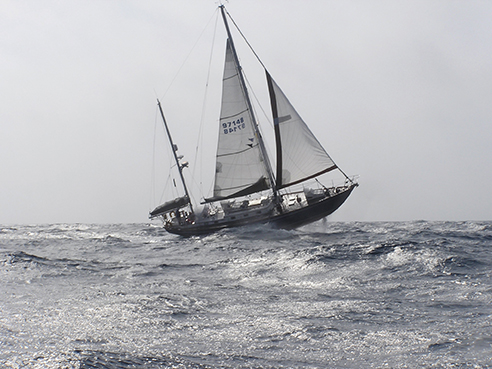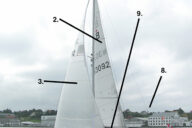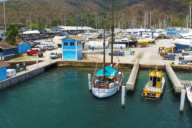Brian Hancock helps make a practical analysis of choosing the correct headsail. Originally published in BWS.
Luckily, these days with modern sail materials and well proven equipment, your sails can cover a broader wind range and changing gears as the wind fluctuates is easier than ever. With that in mind let’s take a look at what sails will work for you and since hopefully there will be a lot of downwind sailing in your future, let’s start by looking at spinnakers and other sails that you can use when the wind is at your back and the horizon ahead is like open arms just waiting for you.

DOWNWIND
There are a number of options for downwind sailing starting with a traditional symmetrical spinnaker, the increasingly popular asymmetrical spinnaker, and a variety of headsails that can be poled out on a spinnaker or whisker pole. It’s easy to think that the days of conventional spinnakers are numbered given that the asymmetrical is so much less work and less complicated to set and douse, but let’s not count it out just yet. I have talked to a number of sailors who have undertaken extended voyages and they love their spinnakers, especially in the tropics and trade winds. Racing sailors like to “heat” things up and sail downwind angles, but for cruisers, especially those lugging heavy displacement boats around, sailing deep downwind angles is the way to go. In addition to many cruising boats being on the heavy side, they are often laden with food, fuel and water so sailing as far off the wind as possible is preferable. In order to do so you need to be able to get the spinnaker as far out from the lee of the mainsail as possible. The best way to accomplish this of course is with a spinnaker pole rotated well aft. Cruisers will tell you that yes it’s a bit of a grind rigging up the topping lift, foreguy, after-guy and the rest, but once the sail is set it requires very little attention. Their only concern is a sudden squall and for that reason many will lower the spinnaker at night and sail with a poled out headsail.
When I raced in the 1981/1982 Whitbread Round the World Race we faced the same problem of sudden wind increases and because we were racing we were carrying our spinnakers in much stronger winds. Squalls are hard to see, especially at night, so we developed a neat trip mechanism to help us get the sail down in a hurry. It required a little extra work when setting the spinnaker. In addition to the after-guy which was led through the end of the spinnaker pole and attached to the sail, we also rigged a pole-guy. This was a line that was used to hold the spinnaker pole in place. This tripping system only works with Tylaska snap shackles, the kind that can be released while still under a load. We would run a short piece of low stretch line through the tripping mechanism of the snap shackle and attach it to the spinnaker pole. Once the spinnaker was set we knew that in seconds we could have the sail down if we were caught by surprise. As soon as the wind filled we would ease the after-guy a few inches. The spinnaker pole would remain fixed in place by the pole-guy, and pressure would come on the snap shackle instantly releasing it allowing the sail to float effortlessly into the lee of the mainsail where is could be easily lowered to the deck.

You can, of course, set an asymmetrical spinnaker on the spinnaker pole and rotate it aft for deep downwind angles. Jibing is a bit more complicated but most cruisers admit to lowering their spinnaker, jibing the boat, and then resetting the spinnaker which is what you have to do with an asymmetrical spinnaker. The big difference between a symmetrical spinnaker and an asymmetrical spinnaker is sail shape. When you are sailing deep downwind angles the wind is actually flowing from the head of the sail down toward the foot. If you have been lucky enough to have sailed with a spinnaker in the trade winds you will remember seeing wind gusts on the water ahead of the boat. This is the wind that has blown down the sail and exited out the bottom creasing the surface of the water. Conventional spinnakers are designed with this in mind and their sail shape is perfect, whereas asymmetrical spinnakers have more of a asymmetrical design where the wind flows across the sail rather than down it. That’s not to say that it won’t work as well and at the end of the day most cruisers are looking for convenience over performance.
Many sailors will set an asymmetrical spinnaker from the bow of the boat or from a bowsprit and this is a quick and easy way to get some sail area up and the boat hauling the mail. You will have to “heat” things up a little bit to get the sail to fill nicely, but the good news is that you don’t have all the hassle (and expense) of the spinnaker pole and associated rigging. If you have a tack line that is led back to the cockpit you can also rig the same trip mechanism for a quick take down.
Spinnaker socks (sleeves) are still very popular and for good reason; they make life easier. Here is a simple trick you should do to make it safer and easier to douse the sail. Attach a ratchet block to the deck or rail and lead the sock control lines through the block. This accomplishes two things; when you are dousing the sail you can stand with your feet squarely on the deck and pull upwards rather than dangling precariously trying to pull the sleeve down over the sail, and also having a ratchet helps in case the spinnaker starts to refill. In any event always make sure that you are dousing the sail in the lee of the mainsail. You need to sail at deep downwind angles and the spinnaker will be easy to tame in the dead air behind the mainsail.
These days top-down furlers are becoming increasingly popular as are Code-0 type sails and asymmetrical spinnakers with anti-torque lines sewn into the luff of the sail. Anti-torque lines used to be prohibitively expensive, but they are coming down in price to an affordable range for cruisers. This makes it especially convenient for someone that wants to be able to set and douse their sails easily. Code 0s are very flat gennakers used at close wind angles and we will discuss them more when we look at the upwind inventory, but they can easily be changed out with an asymmetrical spinnaker that is using a top-down furler meaning that you only need one furling unit for both sails.
A top-down furler is easy to use. The sail is set with an anti-torque line running between the furling drum and the swivel at the top of the sail. With tension on the anti-torque line you can start to roll the sail away. The first thing to roll is the top of the sail, hence the name top-down. This collapses the sail and the rest of it is furled around the anti-torque line. On most units there is a toggle that allows you to use the same furling drum for an asymmetrical as well as a Code-0/gennaker.
Many cruisers like to sail downwind with a headsail poled out to windward balanced with the mainsail to leeward. This is a safe and secure way to make good miles, especially overnight when many don’t want the aggravation of a spinnaker. There are two ways to do this. A simple yankee on the spinnaker or whisker pole works great. An alternative is to set a smaller sail to windward, either loose luffed or sharing a luff groove, and a second sail to leeward. With a bit of messing around you can get the windward sail to feed breeze into the leeward sail greatly improving your performance. Remember that when sailing downwind boats like to be pulled along by the headsails, rather than pushed along by the mainsail.
REACHING
Most offshore passagemaking is reaching with the wind on your beam or slightly aft. The best rig for this is a cutter or some other double headsail rig where you are double-headsail reaching with a yankee or genoa with a raised clew, and a staysail. Wind flowing between the sails is increased because you have split the foretriangle into two and with it comes an increase in performance. You also get a great way to change gears as the wind fluctuates. You can balance the foretriangle by reefing and un-reefing the headsail. If a squall comes through, you can roll the genoa away completely and ride it out on the staysail and reefed main.
For a cutter rig you need an inner-forestay. Many cruising boats have the stay but if not check with the boat’s designer or a rigger to see if you can add it without undue pressure on the mast. If you prefer to avoid installing running backstays, which may be required with an inner stay, consider adding a solent stay which attaches much closer to the masthead. I prefer any sail set on this stay to be hanked-on rather than set on a furling unit. Call me old-fashioned but I like the security of hanks. This stay will be where you set your storm jib and nothing says bulletproof more than hanks. You can even have your sailmaker make up a special bag that wraps around the inner-forestay where you can stow your staysail so that it’s always at the ready. These days, the inner stay can be made of Dyneema Dux or Spectra which is much lighter than wire.
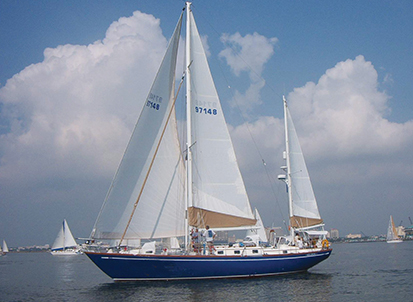
UPWIND
Going upwind is a challenge for many cruisers and many try and get away with a single roller-furling headsail. For day sailing, this may be okay, but if you are going blue water sailing you need at least two working headsails. Here’s why. You need sail area to get your boat moving in light winds and with sail area comes sail camber. Larger sails have a deeper camber to provide power. The problem with camber is that you can’t easily get rid of it when you reef the sail with a furling unit. Most furling headsails have a foam luff that acts to bulk up around the headstay with the bulk there to remove shape from the sail and it does help, but only to a degree. For example a 135 percent LP (luff perpendicular) sail can be safely reefed to around 100 percent, no more. Aside from the camber, there is the problem of fabric strength. Light wind sails are made from lighter fabric which is just not suitable for heavier wind conditions. You need a flat sail shape and a robust fabric when the breeze is up. Note that this is not as important when reaching but we are talking about going to windward now. I suggest that you have a 130-135 percent working genoa that reefs to 100-105 percent and a second one that can take over from there and reef down to around 80-85 percent. Beyond that you can ride things out on the staysail with the headsail rolled away.
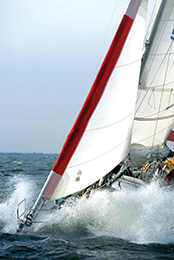
Clew height is always a subject of debate and for good reason. A lower clew headsail gives you better performance but it’s not a good idea for a cruising headsail for a number of reasons. First you need visibility under your headsail so that you can see ships and other boats. A raised clew not only helps with visibility but it also allows waves that crash across the deck to wash out to leeward rather than get scooped up by the sail. Also, the higher the clew the less you have to adjust the lead position and you do need to adjust your lead position each time you reef or unreef the sail. If you simply roll sail area away and leave the lead in the same place you will end up with the leech of the sail twisting off and flapping in the breeze which in turn fatigues the fabric. One of the best things you can do to make sailing easier and improve performance is to add a jib car adjuster. It’s a simple addition and one that allows you to keep your headsail trimmed properly. Well trimmed sails last longer.
LIGHT AIR
Light winds have always presented a challenge to cruising sailors and many opt for the engine to keep things moving. There are some solutions and one of the best things to happen to cruisers is the the anti-torque line and the fact that it’s coming down in cost. The other good thing is light, low stretch fabrics like a light laminate. You can make a very good gennaker out of nylon but you can definitely extend the wind range with a light laminate. The sail is set outside of the headstay meaning that you can leave your genoa in place furled up on the stay. A good Cruising Code-0 can be carried as close as 35-40 degrees apparent which is fine if you are cruising. The wind comes up and you simply roll it away, drop it to the deck and set the headsail.
WHAT WORKS FOR YOU
There are many ways to skin a cat, as they say, and there are also many different kinds of sail combinations. You will have to take what I have written and fine tune things with your sailmaker so that you end up with sails that suit not only your boat, but the kind of sailing that makes you happy. Some people are by nature “fiddlers” and will be happy tinkering whereas others like to “set it and forget it”. No matter the kind of sailor you are things have never been better in terms of sail fabric and engineering and with most sails being built in cheaper labor markets like China, Sri Lanka, and South Africa now is a great time to take a long hard look at your inventory and make some additions to it.
Brian Hancock is a sailmaker, author, lecturer and veteran offshore sailor and racer. He lives in Marblehead, Mass.

